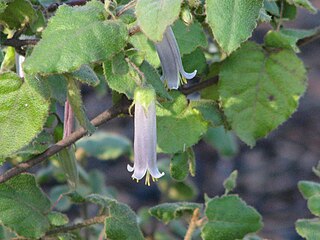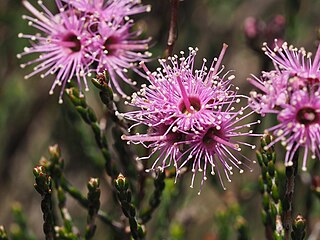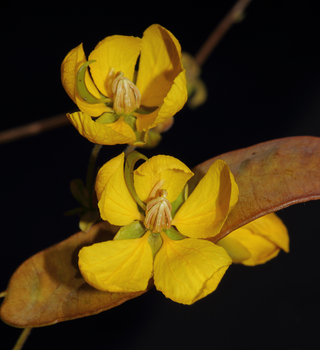
Acradenia euodiiformis, commonly known as yellow satinheart or bonewood, is a species of tree that is endemic to eastern Australia. It has mostly trifoliate leaves, the leaflets narrow elliptic to lance-shaped, with prominent oil glands, and panicles of white flowers. It grows in and near rainforest.

Correa aemula, commonly known as the hairy correa, is a species of shrub that is endemic to south-eastern Australia. It has broadly heart-shaped leaves arranged in opposite pairs, green or greyish green, pendent flowers arranged singly or in pairs and ageing to mauve-purple.

Melicope micrococca, commonly known as hairy-leaved doughwood or white euodia, is a species of shrub or slender tree in the family Rutaceae and is endemic to eastern Australia. It has trifoliate leaves and white flowers borne in panicles in leaf axils.

Senna multiglandulosa, commonly known as glandular senna, downy senna, or buttercup bush is a species of flowering plant in the family Fabaceae and is native to Mexico, Guatemala, and western parts of South America. It is a shrub with pinnate leaves, usually with six to eight pairs of linear to lance-shaped leaflets, and yellow flowers arranged in groups of ten to twenty, with seven fertile stamens in each flower. It is widely cultivated as an ornamental plant and in some areas of the world has become naturalized.

Senna septemtrionalis, commonly known as arsenic bush, is a species of flowering plant in the family Fabaceae and is native to Central America, the southern United States and Mexico, but is naturalised in many other countries. It is an erect shrub with pinnate leaves, with four or five pairs of egg-shaped leaflets, and yellow flowers arranged in groups of five to eight, usually with seven fertile stamens and four staminodes in each flower.

Pimelea congesta is a species of flowering plant in the family Thymelaeaceae and is endemic to Lord Howe Island in Australia. It is a shrub with rough bark, decussate, elliptic leaves and heads of white flowers.

Senna acclinis, commonly known as rainforest cassia or brush senna, is a species of flowering plant in the family Fabaceae and is endemic to near-coastal areas of eastern Australia. It is a shrub with pinnate leaves and bright golden yellow flowers in groups of two to five and long, narrow seed pods. It is similar to other species of Senna that are environmental weeds.

Kunzea opposita is a plant in the myrtle family, Myrtaceae and is endemic to eastern Australia. It is a spindly shrub which has small leaves arranged in opposite pairs, and pink flowers with five petals and many stamens, the stamens much longer than the petals. It usually grows in woodland or on exposed cliffs.

Boronia heterophylla, commonly known as red boronia or Kalgan boronia, is a plant in the citrus family Rutaceae, and is endemic to the south-west of Western Australia. It is an erect, slender shrub with trifoliate leaves and deep pink to red, four-petalled flowers arranged singly in leaf axils.

Commersonia craurophylla, commonly known as brittle leaved rulingia, is a species of flowering plant in the family Malvaceae and endemic to southern continental Australia. It is a dense, spreading shrub with crinkled, narrowly oblong to linear leaves, and white to cream-coloured flowers.

Commersonia magniflora is a species of flowering plant in the family Malvaceae and endemic to Australia. It is an erect shrub with wrinkled, narrowly oblong to elliptic or egg-shaped leaves, and deep pink flowers.

Senna cardiosperma is a species of flowering plant in the family Fabaceae and is endemic to the western half of Australia. It is an erect shrub or small tree with pinnate leaves, the number and shape of the leaflets depending on subspecies, yellow flowers with ten fertile stamens in each flower, and flat pods.
Senna cladophylla is a species of flowering plant in the family Fabaceae and native to Western Australia and the Northern Territory. It is a perennial herb or undershrub with pinnate leaves with two or three pairs of broadly elliptic leaflets, and yellow flowers arranged in pairs, with ten fertile stamens in each flower.
Senna cuthbertsonii is a species of flowering plant in the family Fabaceae and is endemic to northern Western Australia. It is a shrub with pinnate leaves with five to nine pairs of elliptic to narrowly egg-shaped leaflets, the flowers yellow and arranged in groups of two to four, with ten fertile stamens in each flower.
Senna ferraria is a species of flowering plant in the family Fabaceae and is endemic to north-western Western Australia. It is an erect shrub with pinnate leaves with three to four pairs of broadly elliptic to egg-shaped leaflets, and yellow flowers arranged in groups of about twelve, with ten fertile stamens in each flower.
Senna heptanthera is a species of flowering plant in the family Fabaceae and is endemic to Arnhem Land in the north of the Northern Territory. It is a creeping, herbaceous perennial with pinnate leaves with one or two pairs of broadly egg-shaped leaflets, and yellow flowers arranged in groups of eight to ten, with seven fertile stamens in each flower.

Senna magnifolia is a species of flowering plant in the family Fabaceae and is endemic to northern Australia. It is an erect, spreading or straggling, mostly glabrous shrub with pinnate leaves with four to six pairs of broadly oblong to round leaflets, and yellow flowers arranged in groups of twenty to sixty, with seven fertile stamens in each flower.

Senna oligoclada is a species of flowering plant in the family Fabaceae and is endemic to northern Australia. It is an erect shrub with pinnate leaves with one to three pairs of elliptic to egg-shaped leaflets, and yellow flowers arranged in groups of three to five with ten fertile stamens in each flower.

Senna pilocarina is a species of flowering plant in the family Fabaceae and is endemic to inland Western Australia. It is a prostrate or upright, spreading shrub with pinnate leaves with five to nine pairs of oblong to wedge-shaped leaflets, and yellow flowers arranged in groups of four or five, with ten fertile stamens in each flower.

Senna pleurocarpa, commonly known as fire bush or chocolate bush, is a species of flowering plant in the family Fabaceae and is endemic to Australia. It is a spreading shrub with pinnate leaves with five to seven pairs of broadly elliptic to egg-shaped leaflets, and groups of five to twelve yellow flowers arranged in dense groups of twenty to sixty on the ends of branches and in upper leaf axils.



















